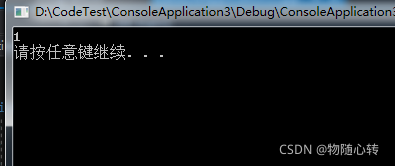一篇文章带你入门C++的异常处理
时间:2022-12-06一、背景
程序运行时常会碰到一些异常情况,例如:
- 做除法的时候除数为 0;
- 用 new 运算符动态分配空间时,空间不够导致无法分配;
- 访问数组元素时,下标越界;打开文件读取时,文件不存在。
这些异常情况,如果不能发现并加以处理,很可能会导致程序崩溃。
所谓“处理”,可以是给出错误提示信息,然后让程序沿一条不会出错的路径继续执行;也可能是不得不结束程序,但在结束前做一些必要的工作,如将内存中的数据写入文件、关闭打开的文件、释放动态分配的内存空间等。
二、C++ 异常处理
C++ 引入了异常处理机制。
异常提供了一种转移程序控制权的方式。C++ 异常处理涉及到三个关键字:try、catch、throw。
- throw: 当问题出现时,程序会抛出一个异常。这是通过使用 throw 关键字来完成的。
- catch: 在您想要处理问题的地方,通过异常处理程序捕获异常。catch 关键字用于捕获异常。
- try: try 块中的代码标识将被激活的特定异常。它后面通常跟着一个或多个 catch 块。
举个例子
#include <iostream>
#include <exception>
using namespace std;
int main () {
try
{
throw 1;
throw "error";
}
catch (const char* str)
{
cout << str << endl;
}
catch (int i)
{
cout << i << endl;
}
}运行结果

也可以自己定义异常类来进行处理:
#include <iostream>
#include <exception>
using namespace std;
//可以自己定义Exception
class myexception: public exception
{
virtual const char* what() const throw()
{
return "My exception happened";
}
}myex;
int main () {
try
{
if(true) //如果,则抛出异常;
throw myex;
}
catch (exception& e)
{
cout << e.what() << endl;
}
return 0;
}
三、抛出异常与捕获异常
可以使用 throw 语句在代码块中的任何地方抛出异常。throw 语句的操作数可以是任意的表达式,表达式的结果的类型决定了抛出的异常的类型。
以下是尝试除以零时抛出异常的实例:
#include <iostream>
using namespace std;
double division(int a, int b)
{
if( b == 0 )
{
throw "Division by zero condition!";
}
return (a/b);
}
int main ()
{
int x = 50;
int y = 0;
double z = 0;
try {
z = division(x, y);
cout << z << endl;
}catch (const char* msg) {
cerr << msg << endl;
}
return 0;
}运行结果

四、catch(...)的作用
catch(…)能够捕获多种数据类型的异常对象,所以它提供给程序员一种对异常对象更好的控制手段,使开发的软件系统有很好的可靠性。因此一个比较有经验的程序员通常会这样组织编写它的代码模块,如下:
void Func()
{
try
{
// 这里的程序代码完成真正复杂的计算工作,这些代码在执行过程中
// 有可能抛出DataType1、DataType2和DataType3类型的异常对象。
}
catch(DataType1& d1)
{
}
catch(DataType2& d2)
{
}
catch(DataType3& d3)
{
}
catch(…)
{
}
}例子
double division(int a, int b)
{
if (b == 0) {
throw "Division by zero condition!";
}
return (a / b);
}
int main() {
try
{
int res = division(10,0);
}
catch (...)
{
cout << " * ********" << endl;
}
return 0;
}
参考:
C++异常处理(try catch throw)完全攻略
c++中try catch的用法
C++ 异常处理
总结
本篇文章就到这里了,希望能够给你带来帮助,也希望您能够多多关注html5模板网的更多内容!
 C++内存模型和名称空间详解这篇文章主要给大家介绍了关于C/C++中的内存模型和名称空间详解,文中通过示例代码介绍的非常详细,对大家学习或者使用
C++内存模型和名称空间详解这篇文章主要给大家介绍了关于C/C++中的内存模型和名称空间详解,文中通过示例代码介绍的非常详细,对大家学习或者使用